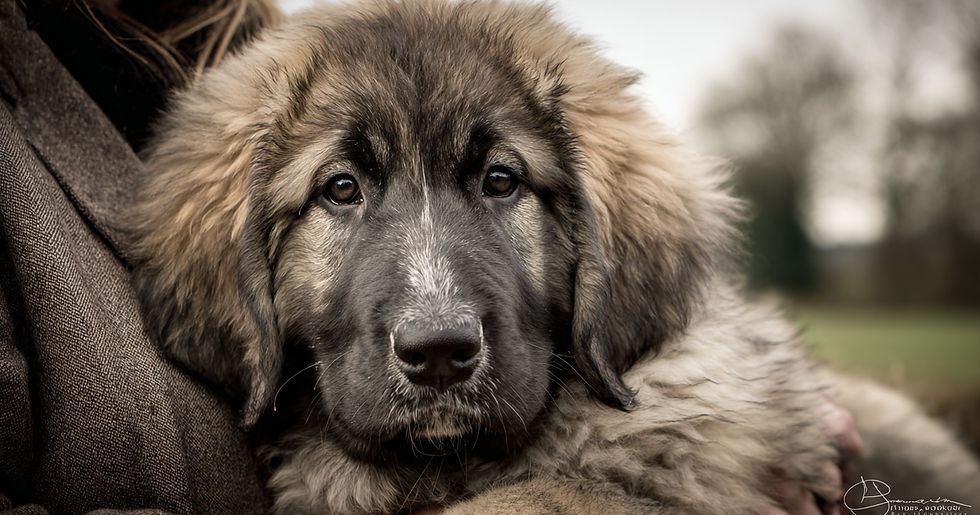How to Introduce a Puppy to the Leash, Collar, and Harness
- nannykp76
- Oct 13
- 5 min read

Setting the Stage for Confident Adventures
Introducing a collar, harness, and leash is one of the first steps in raising a well-adjusted puppy. This process sets the foundation for leash walking, safety during outings, and building trust in handling. When done thoughtfully and gradually, it can be a positive experience that supports your puppy's confidence and willingness to explore the world alongside you.
This stage is not only about equipment. It is about communication, patience, and helping your puppy feel safe in new experiences. Every moment you spend building comfort with gear is also shaping their ability to handle change and trust you in unfamiliar situations.
Timing Matters: When to Begin
It is safe to begin introducing a collar or harness as early as eight weeks old. At this age, puppies are in a critical socialization window and are naturally curious about new experiences. They are learning what is safe and what is scary, and the way you introduce new things now will have lasting effects.
The goal is not to start long walks right away. Instead, focus on building comfort and positive association with the gear they will wear for the rest of their life. Think of it as laying a gentle foundation, one that will support confident walks for years to come.
Step One: Choosing the Right Gear
The right equipment makes all the difference in creating a smooth introduction. Start with lightweight, comfortable gear that will not overwhelm a small puppy. The collar and harness should fit snugly without being too tight or too loose. A good rule of thumb is that you should be able to fit two fingers between the gear and your puppy's body.
The leash should be soft, flexible, and easy to manage indoors. Nylon or biothane leashes are common choices, but some caregivers prefer cotton leads for their lighter feel.
Recommended gear:
A flat collar or martingale collar for ID tags.
A soft front-clip or back-clip harness designed specifically for puppies.
A four- to six-foot leash (avoid retractable leashes during early training).
Avoid equipment that restricts movement, feels heavy, or causes discomfort. This stage is about comfort, freedom of movement, and building positive associations.
Step Two: Getting Comfortable with the Gear
Before clipping anything onto your puppy, allow them to investigate the leash, collar, and harness. Lay them on the floor and pair the gear with treats or play so your puppy associates the sight and smell of the items with good things.
Once your puppy shows curiosity or comfort:
Gently place the collar or harness on.
Give a treat immediately.
Remove it after a few seconds or minutes depending on the session.
Repeat this several times a day over a few days, slowly increasing how long the gear stays on. Always watch for signs of stress such as excessive scratching, whining, or resistance. If needed, slow down, shorten sessions, and increase the number of rewards.
Remember that puppies are learning through repetition. Every time the gear appears and something good happens, they are building trust in the process.
Step Three: Introducing the Leash
Once your puppy is comfortable wearing a collar or harness, you can attach the leash indoors. Let them drag it around under supervision so they get used to its weight and the sensation of something following them. Make sure the area is safe and free of furniture or objects that could snag the leash.
After your puppy is comfortable dragging the leash, begin holding it loosely:
Stay calm and relaxed.
Do not pull or correct.
Reward the puppy for checking in, walking beside you, or responding to gentle guidance.
If your puppy resists or lies down, do not drag or force movement. Instead, use a cheerful voice, gentle coaxing, or a treat to encourage a few steps. Always end on a positive note so that each session builds trust.
Step Four: Practicing Indoors First
Before heading outdoors, practice "leash walks" inside the home or in a backyard. These spaces are familiar and low in distractions, which allows your puppy to focus on you and the new sensations.
Use these sessions to teach your puppy that leash time is positive, calm, and rewarding. Encourage loose leash walking by praising and treating when your puppy stays close or makes eye contact. Avoid letting them pull too far ahead or lag behind. These early patterns will shape their future leash habits.
You can even turn leash practice into a game. Walk a few steps, stop, and reward when your puppy looks up at you. Move in different directions and reward again for following. This builds engagement and makes the leash part of play.
Step Five: Moving to Outdoor Spaces
Once your puppy is comfortable indoors and has received their initial vaccinations, begin practicing in quiet outdoor environments. Choose spaces with fewer distractions such as a calm side street, a friend’s yard, or a quiet park.
The world outside will be full of new sights, smells, and sounds, so keep these first sessions short and positive. Watch closely for body language that shows curiosity, excitement, or nervousness. Offer praise, treats, and gentle redirection to guide your puppy through these encounters.
Be patient. Puppies may freeze, pull, or get overstimulated at first. These are normal responses. What matters most is that they feel safe, that they are never forced into overwhelming situations, and that every outing ends on a positive note.
Tips for Success
Keep early sessions short, around five to ten minutes.
Use high-value treats to reward calm behavior and following.
Stay relaxed and upbeat, as tension in you transfers to your puppy.
Avoid correcting or yanking the leash during learning.
Take breaks if your puppy appears tired or overstimulated.
Celebrate small wins, such as putting on the gear without resistance or taking a few steps without pulling.



Comments